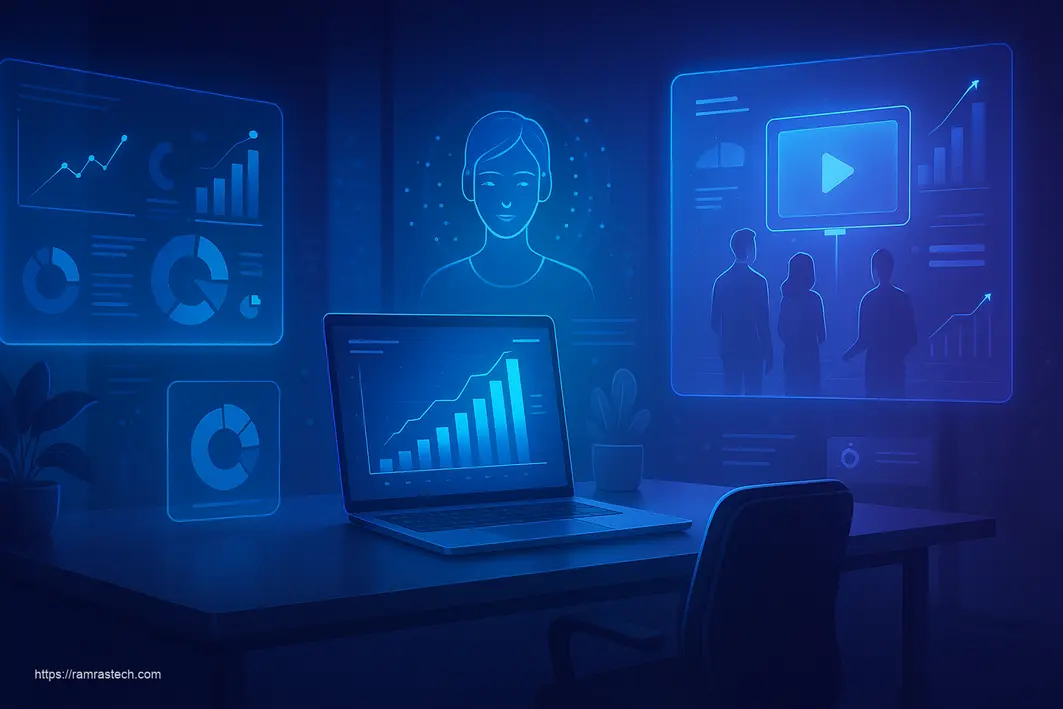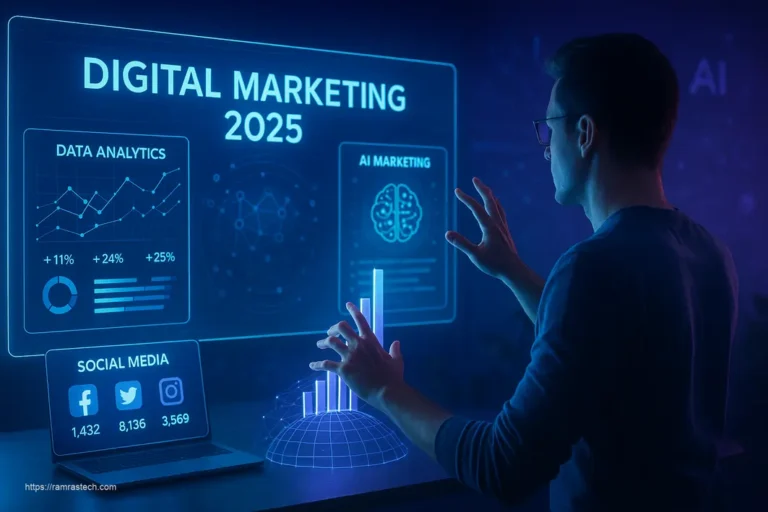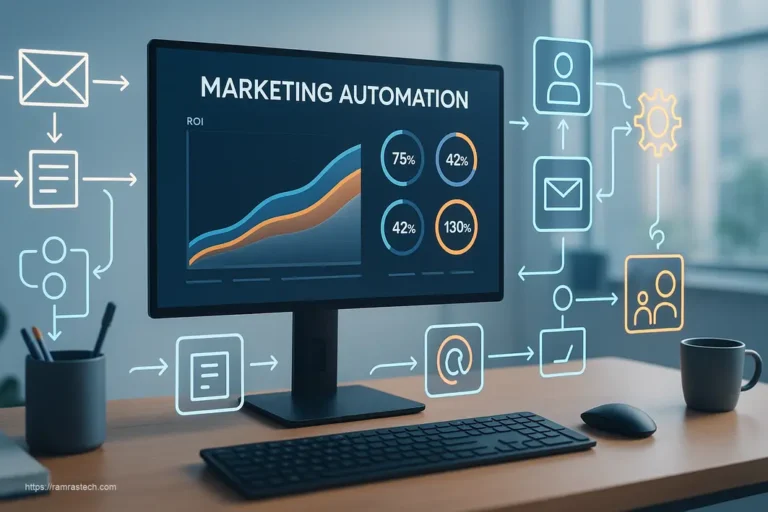Revolutionary Digital Marketing Trends You Can’t Ignore in 2025

The digital landscape is transforming at breakneck speed. Can your brand keep up? As we hurtle toward 2025, the rules of digital marketing aren’t just changing—they’re being completely rewritten by technological innovations that seemed like science fiction just a few years ago. These digital marketing trends aren’t just optional upgrades; they’re survival tools in an increasingly competitive online ecosystem.
The marketing strategies that worked yesterday are rapidly becoming obsolete. Businesses that fail to adapt to these seismic shifts risk disappearing into digital obscurity while forward-thinking brands claim the spotlight. What’s driving this acceleration? A perfect storm of AI advancements, evolving consumer behaviors, and platform innovations that are fundamentally changing how humans interact with technology.
So what does this mean for your business? Let’s explore the revolutionary trends that will separate the digital marketing winners from the left-behind by 2025.
The Hyper-Evolution of Digital Marketing: From Basic to Beyond
The journey of digital marketing represents one of the most dramatic transformations in business history. Remember when having a basic website and sending occasional emails was considered cutting-edge? Those simpler days are long gone.
Digital marketing has undergone several distinct waves of evolution:
- The Billboard Era (1995-2005): Static websites and banner ads dominated the landscape
- The Social Revolution (2005-2015): Facebook, Twitter and other platforms changed how brands connect with audiences
- The Mobile Transformation (2015-2020): Smartphones became the primary digital interface
- The AI Renaissance (2020-present): Machine learning and automation began reshaping every aspect of marketing
Now, we’re entering what many experts call the “Integrated Intelligence Era”—where advanced AI, immersive experiences, and unprecedented personalization converge to create marketing approaches that feel almost sentient.
Why does this matter in 2025? Because digital marketing trends are no longer evolving linearly—they’re advancing exponentially. The gap between early adopters and laggards isn’t just widening; it’s becoming nearly impossible to bridge once you fall behind.
Revolutionary Digital Marketing Trends Reshaping the 2025 Landscape
1. AI Becomes the Marketing Brain
Artificial intelligence has graduated from helpful assistant to essential architect of successful marketing strategies. By 2025, AI won’t just be a tool—it will function as the central nervous system for sophisticated marketing operations.
The numbers tell a compelling story: AI now powers approximately 70% of effective digital marketing strategies, enabling unprecedented levels of personalization, automation, and predictive capability. Brands leveraging advanced AI report 30% higher conversion rates and 25% cost reductions compared to those using more basic approaches.
What does this look like in practice?
- Hyper-personalization engines that analyze thousands of data points to create truly individualized experiences that feel almost clairvoyant
- Predictive journey mapping that anticipates customer needs before they even consciously form
- Creative AI that can generate, test, and optimize content at scales impossible for human teams to match
- Autonomous campaign optimization that continuously refines targeting, messaging, and spending without human intervention
The gap between AI-powered marketing and traditional approaches will become unbridgeable by 2025. Companies still manually handling tasks that AI can perform will find themselves outmaneuvered by competitors with faster insights and more precise execution.
2. Search Becomes Ubiquitous and Multi-Modal
The concept of “searching” is undergoing a profound transformation. Google’s traditional search box, while still important, is no longer the only—or even primary—way consumers discover products and services.
By 2025, search will be everywhere, taking multiple forms across numerous platforms:
- Visual search has exploded, with monthly volumes exceeding 10 billion queries. Consumers increasingly snap photos of products they encounter in real life to find identical or similar items online.
- Voice search continues its meteoric rise, with over 1 billion monthly searches conducted via smart speakers and voice assistants. This is fundamentally changing SEO strategies toward more natural language optimization.
- Social search is perhaps the most disruptive trend, with 40% of Gen Z now using platforms like TikTok and Instagram as their primary search engines rather than Google. This represents a seismic shift in discovery patterns.
The implications are enormous. Brands must optimize their digital presence not just for traditional search engines but for a multi-modal search ecosystem. This requires different content types, formats, and optimization strategies across platforms.
Learn how to optimize your website design for these new search behaviors
3. The Rise of Immersive Marketing Experiences
Flat, passive content is rapidly losing effectiveness as consumers increasingly expect immersive, interactive experiences that blur the line between the physical and digital worlds.
The future of digital marketing is spatially aware, three-dimensional, and deeply engaging:
- Extended Reality (XR) encompassing AR, VR, and mixed reality is moving beyond novelty to become mainstream marketing channels. Furniture retailers now expect customers to visualize products in their own homes via AR before purchasing.
- Spatial commerce enables consumers to shop within fully realized 3D environments, creating emotional connections impossible with traditional e-commerce.
- Digital twins of physical stores and products allow customers to engage with brands in hybrid reality spaces that combine the best of online and offline experiences.
Brands that continue to rely exclusively on traditional 2D content will struggle to hold attention in this new landscape. The most successful marketers in 2025 will create multi-sensory experiences that deliver emotional impact impossible through conventional means.
4. Platform Convergence and Omnichannel Fluidity
The walls between marketing channels are dissolving. By 2025, the concept of separate “channel strategies” will seem as outdated as fax machine marketing.
What’s emerging instead is a fluid omnichannel ecosystem where content, data, and experiences flow seamlessly across touchpoints. Consumers expect perfect continuity as they move between:
- Social media platforms
- E-commerce marketplaces
- Physical retail spaces
- Mobile apps
- Web browsers
- Voice interfaces
- Connected TV environments
This convergence demands sophisticated coordination and integration. Marketing teams are increasingly organized around customer journeys rather than channels, with unified analytics providing a comprehensive view of performance.
Platform-specific strategies are being replaced by cohesive approaches that maintain consistent experiences while adapting to the unique characteristics of each environment. Brands excelling at this integration report 3x higher customer retention rates and 2.5x greater lifetime value.
Discover how to implement seamless omnichannel marketing automation
The Personalization Paradox: When AI Gets Too Personal
The promise of AI-driven personalization is compelling—deliver exactly what each customer wants, when they want it. But by 2025, we’re approaching what some experts call the “personalization paradox”—the point where hyper-targeting becomes counterproductive.
75% of consumers say they’re more likely to purchase from brands that recognize them by name, remember their preferences, and offer relevant recommendations. But simultaneously, 67% report feeling uncomfortable when personalization feels “too accurate” or reveals that brands know more about them than expected.
The most sophisticated marketers are navigating this tension by developing:
- Consensual personalization where customers actively participate in customizing their own experiences
- Transparent data practices that clearly explain how personal information is used
- Value exchanges where personalization is positioned as a benefit consumers receive in exchange for their data
- Ethical AI frameworks that establish boundaries for how prediction engines operate
The winners in 2025’s digital marketing landscape will be those who find the sweet spot—personalization that feels helpful rather than intrusive, creating delighted customers instead of wary ones.
Social Commerce Reinvents the Shopping Journey
The traditional path to purchase—awareness, consideration, conversion—is being collapsed and reimagined through social commerce. By 2025, social platforms won’t just influence purchases; they’ll be where transactions actually happen.
The numbers are staggering: social commerce is projected to exceed $1 trillion in global sales by 2028, with growth curves suggesting it could eventually challenge traditional e-commerce models.
What’s driving this shift?
- Frictionless purchasing removing steps between discovery and checkout
- Social validation where purchases are influenced by community feedback in real-time
- Entertainment commerce blending content consumption and shopping into a unified experience
- Influencer ecosystems that function as complete marketplaces rather than just endorsement channels
This trend fundamentally changes how brands approach digital marketing, with content strategy, community management, and conversion optimization becoming inseparable disciplines.
Explore how small businesses can capitalize on social commerce
The New Influencer Paradigm: Micro, Nano, and Virtual
Influencer marketing isn’t new, but its form and function are evolving dramatically. The mega-influencer model—celebrities with millions of followers promoting products through one-off posts—is yielding to more sophisticated approaches.
By 2025, the most effective influencer strategies will leverage:
- Micro and nano influencers with highly engaged niche audiences who deliver 7x higher engagement rates than celebrity influencers
- Long-term partnerships replacing transactional post-for-pay arrangements with authentic ongoing relationships
- Virtual influencers computer-generated personalities that brands can control completely while still generating real emotional connections with audiences
- Employee advocates internal team members whose authentic enthusiasm reaches networks that trust them implicitly
This evolution addresses the authenticity crisis that has plagued traditional influencer marketing. When 29% of consumers discover brands through social media advertising, much of it influencer-driven, the credibility of these partnerships becomes critical to marketing success.
Brands that continue treating influencers as mere distribution channels will fall behind those developing genuine collaborative relationships that produce mutually beneficial content.
Content Evolution: From Static to Dynamic, Passive to Interactive
Content marketing is undergoing a radical transformation in response to changing consumption habits and technological capabilities. The static blog post (yes, even this one) is becoming just one element in a much richer content ecosystem.
By 2025, leading content strategies will feature:
- Long-form video dominance: The pendulum has swung back from short-form video, with extended content driving deeper engagement. Gen Z viewers are 17% more likely to connect with brands through long-form video than Millennials were at the same age.
- Interactive content that turns passive audiences into active participants through quizzes, configurators, assessments, and playable experiences.
- Dynamic content that automatically adjusts itself based on viewer behavior, preferences, and context.
- User-generated content systems that don’t just incorporate audience contributions but actively encourage and organize them into cohesive brand narratives.
This evolution is driven by fundamental changes in how digital content is consumed. Audiences increasingly expect to participate in, not just consume, the content they engage with.
Discover advanced content marketing strategies to drive engagement
The Privacy-Personalization Balancing Act
The digital marketing landscape of 2025 exists in a post-cookie world where traditional tracking mechanisms have been largely disabled by regulation and platform policies. This presents both challenges and opportunities.
Successful brands are navigating this new reality through:
- First-party data strategies that build direct relationships with consumers instead of relying on third-party data brokers
- Contextual targeting that delivers relevance based on content affinity rather than personal tracking
- Privacy-enhancing technologies that enable personalization while protecting individual identities
- Transparent value exchanges where consumers knowingly trade information for enhanced experiences
This shift represents a return to marketing fundamentals: understanding audiences deeply and creating genuinely valuable experiences rather than simply tracking behavior across the internet.
The most sophisticated marketers view privacy not as an obstacle but as an opportunity to build more meaningful, trust-based customer relationships.
Mobile as the Primary Experience
While mobile optimization has been important for years, 2025 marks the point where mobile becomes the assumed primary interface for most digital experiences. This goes beyond responsive design to mobile-first thinking in every aspect of marketing.
Consider these compelling statistics:
- 61% of mobile users are more likely to contact a business if its website is mobile-friendly
- Local queries with “near me” have surged 500% in recent years
- 88% of consumers who search for a local business on a mobile device visit or call that business within 24 hours
This mobile centrality is changing everything from content creation to conversion optimization:
- Vertical storytelling designed specifically for phone-held viewing
- Voice and gestural interfaces supplementing or replacing traditional navigation
- Location-aware experiences that dynamically adapt based on physical context
- Progressive Web Apps (PWAs) delivering app-like experiences without the friction of installation
Brands still designing primarily for desktop and adapting to mobile will increasingly find themselves at a disadvantage compared to those building for mobile first.
Learn essential strategies for mobile-friendly website design
Values-Based Marketing Becomes Non-Negotiable
By 2025, consumers aren’t just buying products and services—they’re investing in brands that align with their values. This extends far beyond superficial cause marketing to fundamental business practices.
The statistics are clear: 57% of consumers are willing to change purchasing habits to reduce environmental impact, and 71% will pay a premium for brands that demonstrate authentic social responsibility.
Leading brands are responding with:digital marketing trends that emphasize:
- Transparent supply chains visible to consumers through blockchain and other verification technologies
- Sustainable practices woven into product development and business operations
- Genuine social impact measured and reported with the same rigor as financial performance
- Community building that fosters connection between like-minded consumers around shared values
This shift goes deeper than marketing messaging; it requires alignment between what brands say and what they actually do. In an age of information transparency, discrepancies between claimed values and actual behavior become immediately visible and potentially devastating.
The Future Belongs to Adaptive Marketers
Perhaps the most important digital marketing trend for 2025 isn’t a specific technology or tactic but a mindset: adaptive marketing. In a landscape of constant change, the ability to quickly sense shifts, experiment with responses, and scale successful approaches becomes the ultimate competitive advantage.
Adaptive marketing organizations are characterized by:
- Continuous testing cultures that run hundreds of small experiments rather than a few big bets
- Agile team structures organized around customer outcomes rather than marketing functions
- Real-time measurement systems providing immediate feedback on performance
- Learning loops that systematically convert insights into action
This approach represents a fundamental shift from traditional marketing planning—instead of annual strategies executed with minor adjustments, adaptive marketers constantly evolve their approaches based on real-world results.
In practice, this means embracing uncertainty rather than trying to eliminate it, developing hypotheses rather than fixed plans, and optimizing for learning speed rather than perfect execution.
FAQs: Digital Marketing Trends for 2025
What is the single most important digital marketing trend for 2025?
While various trends will impact different industries uniquely, AI integration stands out as the most transformative force across all marketing disciplines. By 2025, AI won’t just optimize campaigns—it will actively shape strategy, create content, and drive personalization at scales impossible for human teams to match. Organizations that fail to develop AI capabilities will face increasingly insurmountable disadvantages in efficiency, personalization, and insight generation.
How will small businesses compete in the AI-driven marketing landscape of 2025?
The democratization of AI tools is actually creating new opportunities for smaller organizations. Cloud-based AI marketing platforms now offer sophisticated capabilities with minimal technical expertise required. Small businesses can leverage these tools to achieve personalization and optimization previously available only to enterprises with large technical teams. The key is focusing on specific use cases that deliver high ROI rather than attempting to implement comprehensive AI systems across all marketing functions simultaneously.
Discover affordable digital marketing strategies for small businesses
Will SEO still matter in 2025?
SEO won’t just matter—it will expand in scope and complexity. As search becomes multi-modal (voice, visual, social) and more integrated into daily life, optimization must evolve beyond traditional keyword strategies. By 2025, effective SEO will encompass entity optimization, visual search readiness, conversational content development, and platform-specific discoverability tactics. The fundamentals of creating valuable, relevant content will remain essential, but the technical implementation will become more sophisticated.
Learn unbeatable SEO tips for 2025
How is social media marketing changing for 2025?
Social media is evolving from primarily a brand-building and engagement channel to a complete customer journey environment. The most significant shifts include the rise of social commerce (purchasing directly within platforms), the fragmentation of platforms for specific audience segments, and the increasing importance of community building over broadcasting. Successful social strategies in 2025 will focus on creating immersive, interactive experiences that convert within the platform rather than driving traffic elsewhere.
What skills will marketers need to succeed in 2025?
The marketing profession is undergoing rapid transformation, requiring a hybrid skill set that combines traditional marketing knowledge with new technical capabilities. The most valuable skills include:
- Data interpretation and insight generation
- AI management (prompt engineering, model training, output evaluation)
- Experience design across multiple modalities
- Test design and experimental thinking
- Ethical framework development for new technologies
- Cross-functional collaboration with product and technology teams
Continuous learning will be non-negotiable as the pace of change accelerates.
Embracing the Future of Digital Marketing
The digital marketing trends reshaping 2025 represent both extraordinary opportunities and existential challenges for brands. Those who embrace these changes—integrating AI, adapting to new search paradigms, creating immersive experiences, and building value-aligned relationships with consumers—will thrive in this new landscape.
Those who cling to outdated approaches, treating these trends as optional enhancements rather than fundamental shifts, risk rapid obsolescence in an increasingly competitive digital ecosystem.
The good news? There’s still time to prepare. By investing in the right technologies, developing the necessary capabilities, and fostering adaptive mindsets, organizations can position themselves to ride these trends rather than be overwhelmed by them.
The future of digital marketing isn’t something that happens to us—it’s something we create through the choices we make today. What future will your brand build?
Discover proven digital marketing strategies to dominate in 2025






